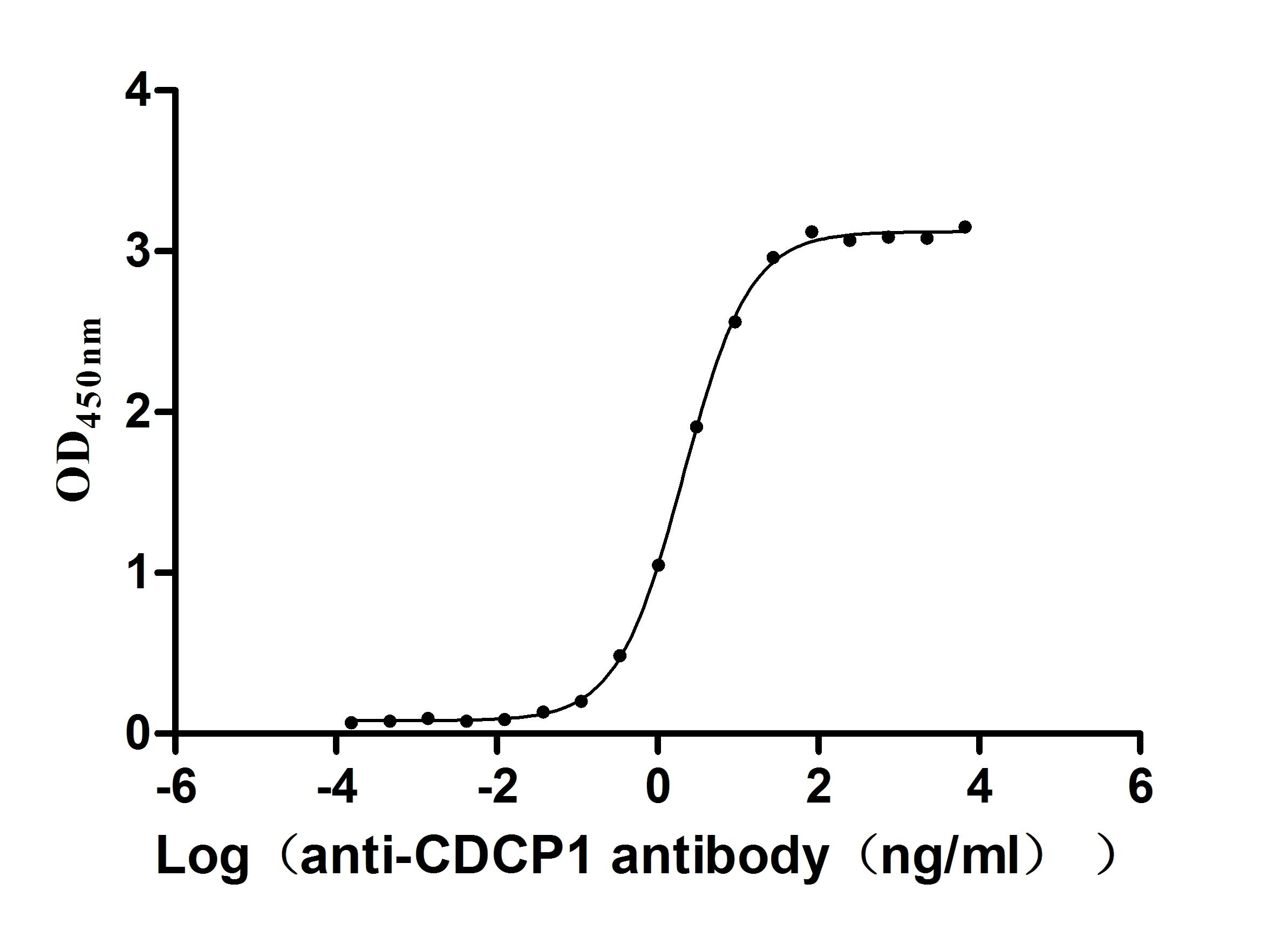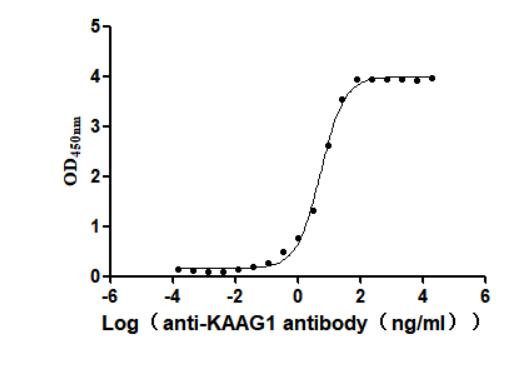Recombinant Human Tumor necrosis factor receptor superfamily member EDAR (EDAR), partial
-
中文名称:人EDAR重组蛋白
-
货号:CSB-YP892357HU
-
规格:
-
来源:Yeast
-
其他:
-
中文名称:人EDAR重组蛋白
-
货号:CSB-EP892357HU
-
规格:
-
来源:E.coli
-
其他:
-
中文名称:人EDAR重组蛋白
-
货号:CSB-EP892357HU-B
-
规格:
-
来源:E.coli
-
共轭:Avi-tag Biotinylated
E. coli biotin ligase (BirA) is highly specific in covalently attaching biotin to the 15 amino acid AviTag peptide. This recombinant protein was biotinylated in vivo by AviTag-BirA technology, which method is BriA catalyzes amide linkage between the biotin and the specific lysine of the AviTag.
-
其他:
-
中文名称:人EDAR重组蛋白
-
货号:CSB-BP892357HU
-
规格:
-
来源:Baculovirus
-
其他:
-
中文名称:人EDAR重组蛋白
-
货号:CSB-MP892357HU
-
规格:
-
来源:Mammalian cell
-
其他:
产品详情
-
纯度:>85% (SDS-PAGE)
-
基因名:EDAR
-
Uniprot No.:
-
别名:Anhidrotic ectodysplasin receptor 1; DL; Downless (mouse) homolog; Downless homolog; Downless mouse homolog of; ECTD10A; ECTD10B; Ectodermal dysplasia receptor; Ectodysplasin 1 anhidrotic receptor; Ectodysplasin A receptor; Ectodysplasin A1 isoform receptor; Ectodysplasin-A receptor; ED 1R; ED 3; ED 5; ED1R; ED3; ED5; EDA 1R; EDA 3; EDA A1 receptor; EDA A1R; EDA-A1 receptor; EDA1R; EDA3; Edar; EDAR_HUMAN; HRM1; Tumor necrosis factor receptor superfamily member EDAR
-
种属:Homo sapiens (Human)
-
蛋白长度:Partial
-
蛋白标签:Tag type will be determined during the manufacturing process.
The tag type will be determined during production process. If you have specified tag type, please tell us and we will develop the specified tag preferentially. -
产品提供形式:Lyophilized powder
Note: We will preferentially ship the format that we have in stock, however, if you have any special requirement for the format, please remark your requirement when placing the order, we will prepare according to your demand. -
复溶:We recommend that this vial be briefly centrifuged prior to opening to bring the contents to the bottom. Please reconstitute protein in deionized sterile water to a concentration of 0.1-1.0 mg/mL.We recommend to add 5-50% of glycerol (final concentration) and aliquot for long-term storage at -20℃/-80℃. Our default final concentration of glycerol is 50%. Customers could use it as reference.
-
储存条件:Store at -20°C/-80°C upon receipt, aliquoting is necessary for mutiple use. Avoid repeated freeze-thaw cycles.
-
保质期:The shelf life is related to many factors, storage state, buffer ingredients, storage temperature and the stability of the protein itself.
Generally, the shelf life of liquid form is 6 months at -20°C/-80°C. The shelf life of lyophilized form is 12 months at -20°C/-80°C. -
货期:Delivery time may differ from different purchasing way or location, please kindly consult your local distributors for specific delivery time.Note: All of our proteins are default shipped with normal blue ice packs, if you request to ship with dry ice, please communicate with us in advance and extra fees will be charged.
-
注意事项:Repeated freezing and thawing is not recommended. Store working aliquots at 4°C for up to one week.
-
Datasheet :Please contact us to get it.
相关产品
靶点详情
-
功能:Receptor for EDA isoform A1, but not for EDA isoform A2. Mediates the activation of NF-kappa-B and JNK. May promote caspase-independent cell death.
-
基因功能参考文献:
- 10 and five quantitative trait-associated mutations for oxygen saturation (SaO2) and blood platelet count, respectively, are identified at the Edar Receptor (EDAR) locus. rs10865026 and rs3749110 (associated with SaO2 and platelet count, respectively) are functional candidate targets. EDAR has undergone natural selection in recent human history and EDAR variants has an important role in Tibetan high-altitude adaptations. PMID: 28795375
- Results suggested that SNPs in EDAR could be a pathogenic factor for non-syndromic tooth agenesis. Furthermore, EDAR can be regarded as a marker gene for the risk of tooth agenesis. PMID: 28808699
- To evaluate the relative contribution of these variants, we performed a second genome-wide scan in 709 samples from the Uyghur, an admixed population with both eastern and western Eurasian ancestries. In Uyghurs, both EDAR (rs3827760: P = 1.92 x 10(-12)) and TCHH (rs11803731: P = 1.46 x 10(-3)) are associated with hair straightness, but EDAR (OR 0.415) has a greater effect than TCHH (OR 0.575). PMID: 27487801
- Partial least square path model confirms EDARV370A systematically affect these weakly related ectodermal-derived characteristics, suggesting the pleiotropic effect of EDARV370A mainly plays roles in early embryo development PMID: 26603699
- Four traits of ear pinna anatomic variation are associated with a functional variant in the EDAR gene, a key regulator of embryonic skin appendage development. PMID: 26105758
- we have identi fi ed a novel frameshift mutation in an Italian family with autosomal dominant hypohidrotic ectodermal dysplasia resulting in a mild clinical phenotype. PMID: 24641098
- Individuals with a c.1072C > T mutation in the EDAR-gene displayed more hair shaft deformations confirming the role of EDAR for human hair follicle development and postnatal hair follicle cycling. PMID: 26336973
- Confirmed that EDARV370A, a variant that first originated in East Asia about 30000 years ago, played an important role in incisor shoveling in East Asia. This suggests that incisor shoveling in modern East Asians appeared after the late Pleistocene. PMID: 24752358
- Individuals with a c.1072C > T mutation in the EDAR-gene displayed a typical pattern of congenitally missing teeth in the frontal area with functional consequences. PMID: 24884697
- Using whole-exome sequencing we describe a novel homozygous missense mutation in EDAR causing autosomal recessive HED associated with palmoplantar hyperkeratosis and the absence of breasts. PMID: 23210707
- Study generated a knockin mouse model and found that, as in humans, hair thickness is increased in EDAR370A mice; new biological targets affected by the mutation were identified, including mammary and eccrine glands. Building on these results EDAR370A was found to be associated with an increased number of active eccrine glands in the Han Chinese. PMID: 23415220
- This is the first report of a founder EDAR mutation and of a significantly high frequency of autosomal recessive HED. PMID: 22032522
- WNT10A and EDAR were each responsible for 16% of hypohidrotic/anhidrotic ectodermal dysplasia cases. PMID: 20979233
- screening of all the 12 exons and splice junctions of gene EDAR revealed a novel missense mutation (c.1163T>C; p.Ile388Thr) in family A and a novel insertion mutation (c.1014insA; p.V339SfsX6) in family B. PMID: 21771270
- Data show that 25 different mutations on EDA and EDAR genes were detected in HED patients. PMID: 20236127
- a novel compound heterozygous mutation [c.52-2A>G; c.212G>A (p.Cys71Tyr)]; significance of the EDAR signalling pathway in the ectodermal morphogenesis. PMID: 20033817
- DNA sequence analysis of EDAR gene in a Pakistani family, demonstrating autosomal recessive form of hypohidrotic ectodermal dysplasia, identified a novel homozygous mutation affecting splice donor site of exon 5 [IVS5+1G > or = C] of the gene PMID: 20199431
- isoforms of EDA-A5 and A5',activated NF-kappaB through receptors EDAR and XEDAR PMID: 16423472
- EDAR mutations account for one-quarter of non-ED1-related hypohidrotic ectodermal dyspl PMID: 16435307
- novel deletion mutation in a Pakistani family with autosomal recessive hypohidrotic ectodermal dysplasia PMID: 17501952
- study reports the molecular analyses of four patients from India with hypohidrotic ectodermal dysplasia, three who harbour novel mutations, two in the EDA gene and one in the EDAR gene PMID: 17970812
- EDAR is a major genetic determinant of Asian hair thickness and the 1540C allele spread through Asian populations due to recent positive selection PMID: 18065779
- Patients with homozygous or compound heterozygous mutations in the EDAR gene have a more severe phenotype of hypohidrotic ectodermal dysplasia than those with a heterozygous missense, nonsense or frame-shift mutation PMID: 18231121
- Study shows that the derived EDAR370A common in East Asia has a more potent signaling output than the ancestral EDAR370 V; shows that elevation of Edar activity in transgenic mice converts their hair phenotype to the typical East Asian morphology. PMID: 18561327
- EDAR is the genetic determinant of hair thickness as well as a strong contributor to hair fiber thickness variation among Asian populations. PMID: 18704500
- results expand the allelic series for mutations underlying hypohidrotic ectodermal dysplasia PMID: 19438931
- Recurrent mutations in functionally-related EDA and EDAR genes underlie X-linked isolated hypodontia and autosomal recessive hypohidrotic ectodermal dysplasia. PMID: 19551394
- an EDAR variant is a genetic determinant of shovel-shaped incisors PMID: 19804850
显示更多
收起更多
-
相关疾病:Ectodermal dysplasia 10A, hypohidrotic/hair/nail type, autosomal dominant (ECTD10A); Ectodermal dysplasia 10B, hypohidrotic/hair/tooth type, autosomal recessive (ECTD10B)
-
亚细胞定位:Membrane; Single-pass type I membrane protein.
-
组织特异性:Detected in fetal kidney, lung, skin and cultured neonatal epidermal keratinocytes. Not detected in lymphoblast and fibroblast cell lines.
-
数据库链接:
HGNC: 2895
OMIM: 129490
KEGG: hsa:10913
STRING: 9606.ENSP00000258443
UniGene: Hs.171971
Most popular with customers
-
Recombinant Human Receptor tyrosine-protein kinase erbB-3 (ERBB3), partial (Active)
Express system: Mammalian cell
Species: Homo sapiens (Human)
-
Recombinant Human Prolactin receptor (PRLR), partial (Active)
Express system: Mammalian cell
Species: Homo sapiens (Human)
-
Recombinant Macaca mulatta Semaphorin-4D isoform 1 (SEMA4D), partial (Active)
Express system: Mammalian cell
Species: Macaca mulatta (Rhesus macaque)
-
Recombinant Macaca fascicularis CUB domain containing protein 1 (CDCP1), partial (Active)
Express system: Mammalian cell
Species: Macaca fascicularis (Crab-eating macaque) (Cynomolgus monkey)
-
Recombinant Human Cadherin-1(CDH1),partial (Active)
Express system: Mammalian cell
Species: Homo sapiens (Human)
-
Recombinant Human Kidney-associated antigen 1(KAAG1) (Active)
Express system: Baculovirus
Species: Homo sapiens (Human)
-
Recombinant Human Interleukin-12 receptor subunit beta-1(IL12RB1),partial (Active)
Express system: Mammalian cell
Species: Homo sapiens (Human)
-
Recombinant Human Tumor necrosis factor ligand superfamily member 15(TNFSF15) (Active)
Express system: Mammalian cell
Species: Homo sapiens (Human)









-AC1.jpg)










